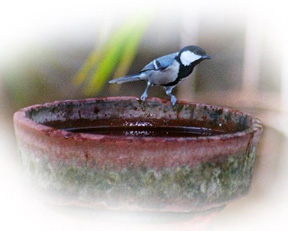Grey Tit ( Parus major)
-Ragoo Rao
This month the bird I have selected is the Grey tit. Since the rains are almost ending, the insect population is at its peak and active. This is the season when one finds
the Grey tit being actively noticed flittering from branch to branch looking for insects under the leaves and twigs.
A small sparrow sized bird with a striking black head and grey body which is whitish in the underside.
A prominent black band all round the neck tapering down the centre of the chest right down to the end is the distinguishing feature of the Grey tit. Another prominent feature is the white cheek patches. Both sexes are alike,
only a slight difference in size distinguishes the female, which is
smaller.

These are restless birds flicking from twig to twig almost in jerks looking for insects hidden under the leaves and on tree trunks. Another marvelous feature of this bird
is its fancy to cling upside down on tree trunks foraging for insects.
Their distribution is through out the country all though there are five races slightly differing in coloration hues.
It is mostly seen in urban gardens with medium sized trees foraging for insects, especially during dusk, for this is the time for insects to venture out. These birds are often seen along with Bulbuls and other similar insectivorous birds like the tailor
bird and small warblers during this time.
A very restless bird, they fly away at the slightest noise or a disturbance.
Water seems to be its weakness, for it is sure a accept a drink if one provides a bird bath at a quiet shady place in the garden.
If they like the peace around they almost make it their own water source and might even settle for their regular baths. This is a sure way of inviting these birds to your garden and observing them quietly. They seem to like being photographed. Most of
the grey tit's photographs looks like the birds have been posing for a good picture.
Their chirping while foraging in trees...Twee..chichi....whee...chichi...is very reminiscent of the male house sparrow's chirps. During breeding season the male can be seen
taking a high position in a medium sized tree and loudly and clearly going...
hee...chi..chi...whee..chichi...
continuously trying to impress the females. Whether they pair for life or not is a matter to be studied and confirmed, for they are always seen in pairs rather than flocks.
Nesting season varies with locality but broadly it is between Feb to Nov and sometimes they even raise two broods in a year. Very much like the domestic sparrow.
They select a hole in a tree or a niche in a high wall. The nests are lined with moss, feathers and animal hair.
Normally 4 to 6 whitish, spotted or speckled with brown eggs are laid.
Both sexes share all domestic chores.
A beautiful bird which is a challenge to bird photographers to get a good shot at it.
Lets cherish this bird and marvel at nature’s creations.